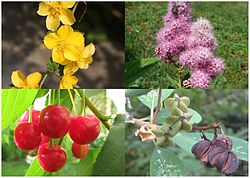| Amygdaloideae Temporal range: Possible Albian record [2] | |
|---|---|
 | |
| (clockwise from top-left) Kerria japonica , Spiraea sp., Exochorda racemosa , Prunus cerasus | |
| Scientific classification | |
| Kingdom: | Plantae |
| Clade: | Tracheophytes |
| Clade: | Angiosperms |
| Clade: | Eudicots |
| Clade: | Rosids |
| Order: | Rosales |
| Family: | Rosaceae |
| Subfamily: | Amygdaloideae Arn. |
| Tribes | |
| Synonyms | |
| |
Amygdaloideae is a subfamily within the flowering plant family Rosaceae. It was formerly considered by some authors to be separate from Rosaceae, [3] and the family names Prunaceae and Amygdalaceae have been used. Reanalysis from 2007 has shown that the previous definition of subfamily Spiraeoideae was paraphyletic. [4] To solve this problem, a larger subfamily was defined that includes the former Amygdaloideae, Spiraeoideae, and Maloideae. This subfamily, however, is to be called Amygdaloideae rather than Spiraeoideae under the International Code of Nomenclature for algae, fungi, and plants as updated in 2011. [5]
Contents
As traditionally defined, the Amygdaloideae includes such commercially important crops as plum, cherry, apricot, peach, and almond. The fruit of these plants are known as stone fruit (drupes), as each fruit contains a hard shell (the endocarp) called a stone or pit, which contains the single seed.
The expanded definition of the Amygdaloideae adds to these commercially important crops such as apples and pears that have pome fruit, and also important ornamental plants such as Spiraea and Aruncus that have hard dry fruits.